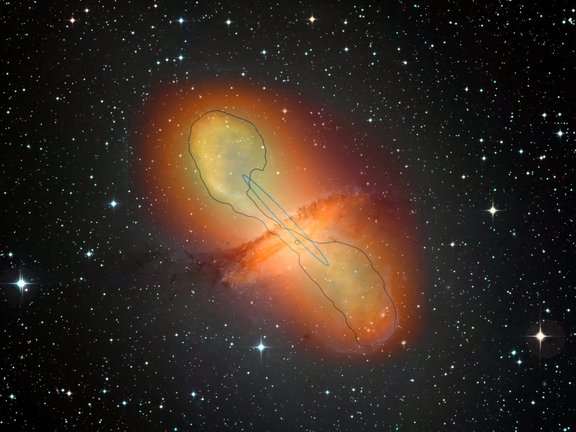Over the past few years, scientists have observed the Universe using gamma rays, which are very high-energy photons. These photons originate from regions of the Universe where electrons are accelerated to huge energies unattainable in human built accelerators. A range of cosmic accelerators, such as accreting supermassive black hole systems at the heart of certain galaxies, give rise to energetic photons such as X–ray and gamma-rays. The intensity of the radiation emitted from these systems can vary over very short timescales of up to one minute, suggestive of an origin close to the central black hole. Additionally, scientists have debated the origin of the X-ray emission in the outflows of these objects, with one scenario requiring extremely energetic (50 TeV) electron acceleration. Since electrons accelerated within the jet lose energy quickly, they therefore need to be kept energised to exist all along the jet.
Using the H.E.S.S. observatory in Namibia, an international astrophysics collaboration observed a radio galaxy (a galaxy that is highly luminous when observed at radio wavelengths) for over 200 hours at unparalleled resolution. As the nearest radio galaxy to Earth, Centaurus A, was favourable to H.E.S.S. scientists for such a study, enabling them to identify the region emitting the very high-energy radiation while studying the trajectory of the plasma jets. Based on dedicated analysis efforts by groups in Innsbruck and Paris, they were able to show that the gamma-ray source extended over a distance of several thousand light-years. This extended emission was demonstrated by groups in Heidelberg and Berlin to indicate that particle acceleration does not take place solely in the vicinity of the black hole but also along the entire length of the plasma jets. Based on these new results, it is now believed that continuous acceleration takes place all along the jet. The discovery suggests that many radio galaxies with extended jets do indeed efficiently accelerate particles up to extreme energies.
This finding therefore brings crucial new information to the debate on the origin of the X-ray emission. As highlighted by H.E.S.S. scientist Frank Rieger from the Heidelberg Max Planck Institute for Nuclear Physics, one of the corresponding authors of the publication: “This discovery revolutionises our understanding of large-scale jets and brings our understanding of cosmic particle acceleration a huge step forward. It is deeply satisfying to see long-term observational efforts paying off dividends like this. Indeed, we continue to enjoy being surprised by our close friends when looked at in a different way.”
The results of this study required extensive observations and optimized analysis techniques with the most sensitive gamma-ray observatory to date. Next-generation telescopes (Cherenkov Telescope Array, or CTA) will no doubt make it possible to observe this phenomenon in even greater detail.
H.E.S.S.
The H.E.S.S. International Observatory, consisting of five telescopes located in Namibia, involves laboratories from thirteen countries (mainly France and Germany, but also Namibia, South Africa, Ireland, Armenia, Poland, Australia, Austria, Sweden, the United Kingdom, the Netherlands and Japan).
Original publication:
Resolving acceleration to very high energies along the Jet of Centaurus A
The H.E.S.S. Collaboration
Nature 582, 356–359 (2020), DOI: 10.1038/s41586-020-2354-1
Weblinks:
